To prevent cats from getting on your furniture, use a combination of training techniques, deterrents, and engaging alternatives that cater to their natural behaviors. Employ clear commands such as “no” or “off” to establish boundaries, and consider rewarding good behavior with treats as positive reinforcement. Experiment with natural repellents like vinegar or citrus sprays, or try placing double-sided tape on surfaces to discourage jumping. Provide cat trees, scratching posts, and interactive toys to redirect their energy. Consistent training is essential, and adjusting to your cat’s individual preferences can lead to better results. Keep trying different approaches to find the most effective ways to create a cat-free environment.
Key Takeaways
- Use consistent vocal commands like "no" or "off" to deter cats from jumping on furniture.
- Apply vinegar-based or citrus-scented sprays on furniture to create unpleasant odors for cats.
- Provide engaging alternatives, such as scratching posts and interactive toys, to redirect their attention.
- Utilize double-sided tape on surfaces to create a sticky barrier that discourages jumping.
- Create a stimulating environment with cat trees and cozy hideouts to reduce interest in furniture.
Understanding Cat Behavior
Cats are curious creatures, often finding their way onto furniture that offers warmth and comfort. You might notice how your cat gravitates toward soft, cushioned surfaces and sunny spots. This attraction isn't merely a whim; it stems from their natural instincts.
Cats seek out familiar scents on furniture, often looking for spaces that smell like you or carry their own scent markings. Additionally, understanding key aspects of emotional and psychological growth in animals can offer insights into their behavior, as comfort plays a significant role in their overall well-being.
Understanding cat behavior is essential in your efforts to keep cats off furniture. They instinctively climb and explore elevated spaces, so your couch or chair becomes an inviting territory. Recognizing this can help you create alternative spaces that meet their needs without sacrificing your furniture.
Consider providing warm, soft beds or climbing trees in areas they can safely explore. Redirecting their attention away from your furniture is important, and it's critical to remember that cats are sensitive to their environment.
Training Techniques
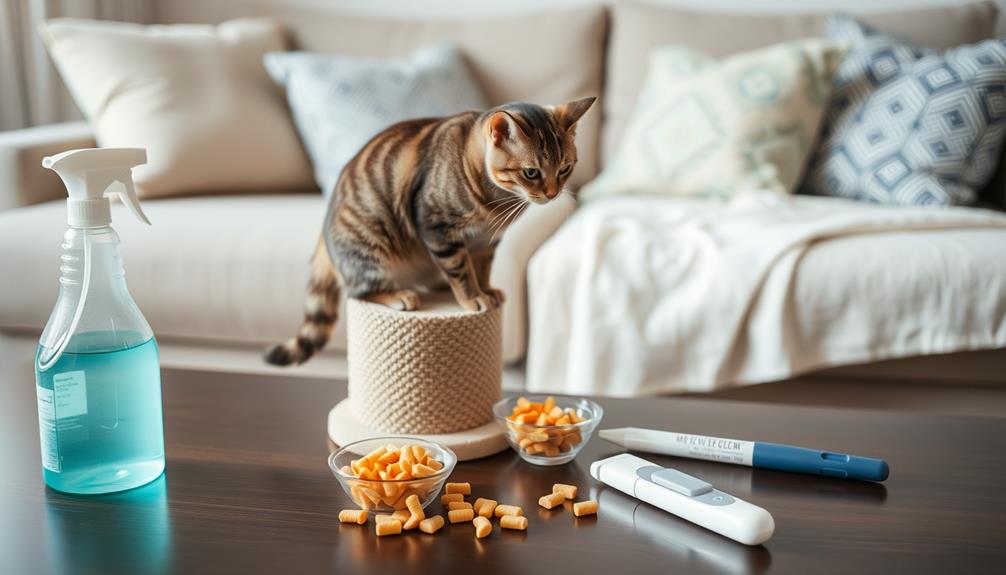
To effectively train your cat to stay off the furniture, you need to use consistent commands every time.
Understanding the importance of emotional regulation, similar to managing relationships with individuals who've BPD dynamics in relationships, can also aid in your approach.
Positive reinforcement, like treats or praise, can encourage them to follow the rules, while real-time behavior correction helps them understand what's not allowed.
Consistent Command Usage
While training your cat to stay off furniture, using consistent commands is essential for success. Firm vocal commands like "no" or "off" can effectively deter your cat, as they respond better to tone than to words.
Incorporating gentle distractions, like a specific yoga pose, can also redirect your cat's attention away from the furniture. When you catch your cat jumping on the furniture, immediately remove them from that spot. This action reinforces boundaries and teaches them that such behavior is unacceptable.
Consistency in your command usage and reactions is critical. Always use the same words and tone during training sessions to help your cat understand and remember the rules. If you vary your commands, it can confuse them and hinder their learning process.
Remember, patience is key. It might take time for your cat to adapt to your commands. Staying strong enough to stick to your training approach is essential.
Regularly repeating your commands and following through with immediate consequences builds a solid foundation for your cat's understanding.
Ultimately, keeping your cat off the furniture requires a commitment to consistent command usage, so stay dedicated to helping your furry friend learn their place in your home.
Positive Reinforcement Strategies
Building on consistent command usage, positive reinforcement strategies can greatly enhance your training efforts. This technique involves rewarding your cat with treats or praise immediately after they use a designated scratching post instead of jumping on your furniture. For example, try clicker training: when your cat avoids the furniture, click the device and give a treat to reinforce this behavior.
To effectively redirect your cat's instincts, gradually introduce new items like cat scratchers or cat trees into your home. Each time your cat uses them, offer a treat to encourage this positive behavior.
Remember, consistency is key. All family members should apply the same training techniques and rewards to reinforce the desired behavior over time.
Additionally, monitoring your cat's progress is essential. Keep an eye on how they respond to different rewards and adjust your strategy based on their preferences. If they seem to prefer certain treats over others, use those to enhance the effectiveness of your positive reinforcement strategies.
This approach not only helps keep your furniture safe but also strengthens your bond with your feline friend.
Real-Time Behavior Correction
When your cat jumps on the furniture, real-time behavior correction can effectively establish boundaries and discourage unwanted habits. One of the most impactful techniques is immediate verbal correction. Use a firm tone to reinforce the "off" command right when it happens. Physically removing your cat from the furniture strengthens their association between the undesired behavior and the correction.
Another effective method is using a squirt bottle filled with water. Cats typically dislike the surprise of getting sprayed, making it a useful deterrent. However, consistency in applying corrections is essential. Here's a quick reference table to help you remember the techniques:
| Technique | Description | Key Points |
|---|---|---|
| Immediate Verbal Correction | Firmly telling your cat "off" when they jump on furniture | Establishes boundaries |
| Physical Removal | Gently lifting your cat off the furniture | Reinforces the correction |
| Squirt Bottle | Spraying your cat with water when they misbehave | Surprising deterrent |
| Clicker Training | Rewarding appropriate behavior with a click | Reinforces positive actions |
Effective Repellent Options

If you want to keep your furniture cat-free, consider using vinegar-based repellent solutions or citrus scents.
Both options are effective because they tap into your cat's sensitive nose.
You can also explore commercial deterrent sprays that are specifically designed to repel felines.
Vinegar-Based Repellent Solutions
One effective way to keep your cats off furniture is by using a vinegar-based repellent solution. You can create this cat deterrent by mixing equal parts of white vinegar, castile soap, and water in a spray bottle. The strong scent of vinegar is unappealing to cats, making it an effective and safe option.
To apply the vinegar solution, spray areas where your cats frequently jump, such as couches or chairs. Initially, you'll need to spray daily until your cats learn to avoid those spots. If your cats seem unfazed, you can adjust the vinegar-to-water ratio to create a stronger solution based on their reactions.
What makes this method even better is that vinegar is readily available and non-staining on most fabrics, providing a convenient way to protect your furniture.
Plus, it's non-toxic, so you don't have to worry about harming your pets. With a little consistency and a simple vinegar solution, you can effectively deter your cats from lounging on your favorite furniture.
Give it a try and enjoy a cat-free space!
Citrus Scent Deterrents
Cats often dislike strong scents, and citrus is no exception. You can use this to your advantage by incorporating citrus scents to keep your feline friend off your furniture. One effective option is creating a DIY citrus spray. Simply mix water with essential oils or fresh citrus juice in a spray bottle, and apply it to your furniture. This natural cat repellent can help deter your cat from lounging where you don't want them.
If you prefer a ready-made solution, look for a commercial citrus-scented cat deterrent at your local pet store. These sprays typically cost around $5 and often contain safe, natural ingredients that repel cats effectively. Just remember that regular application may be necessary, as the scent can fade, especially in high-traffic areas.
Another simple yet effective approach is to place citrus peels strategically around your furniture. Cats tend to avoid areas with strong citrus odors, making this a natural and easy deterrent.
Commercial Deterrent Sprays
Commercial deterrent sprays offer a straightforward solution for cat owners looking to keep their furniture safe from curious paws.
These commercial cat deterrent sprays are readily available in pet stores, typically costing around $5 per bottle. Many contain natural cat repellent ingredients, like vinegar or citrus scents, that effectively repel cats due to their sensitive noses.
What's great about these sprays is their ease of use. You can apply them immediately without any mixing or preparation, making them a convenient choice for busy cat owners.
Look for products specifically formulated to be non-toxic to pets, ensuring your furry friend's safety while you protect your furniture.
To maximize their effectiveness, make sure to apply the sprays regularly, especially in areas where your cat tends to lounge. This routine helps reinforce boundaries, encouraging your cat to avoid those tempting spots.
If you prefer a DIY approach, a simple vinegar mixture can also serve as a natural repellent. However, for quick results, commercial options are often the best bet.
Using Double-Sided Tape
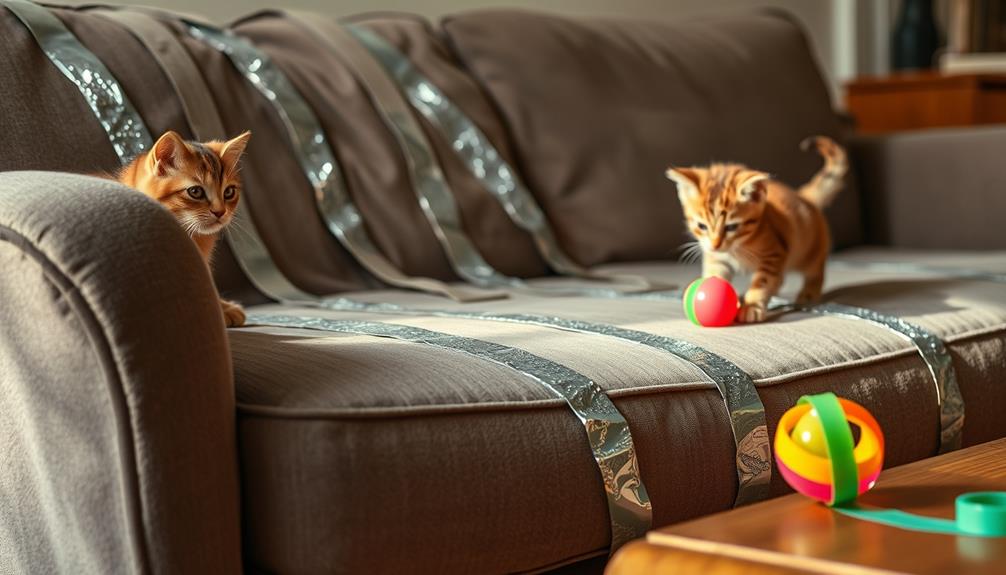
Using double-sided tape can be a simple yet effective way to keep your feline friend off your furniture. Cats usually dislike the sticky sensation on their paws, making this an excellent deterrent. For a cost of less than $3, it's an affordable solution for protecting your beloved furniture.
To use this method, place one-inch strips of double-sided tape on the surfaces you want to keep cats away from. Make certain the tape is visible and easily detectable, as this will help your cat associate the sticky texture with an unpleasant experience.
Over time, your cat will learn to avoid those areas, helping you maintain your furniture's integrity. This technique can serve as a temporary solution until your cat adjusts to staying off the furniture.
Plus, double-sided tape is easy to remove once you notice your cat has learned the lesson. It's a non-invasive way to modify behavior without resorting to harsher methods. So, give double-sided tape a try and watch as your cat learns to respect your furniture!
Engaging Alternatives for Cats
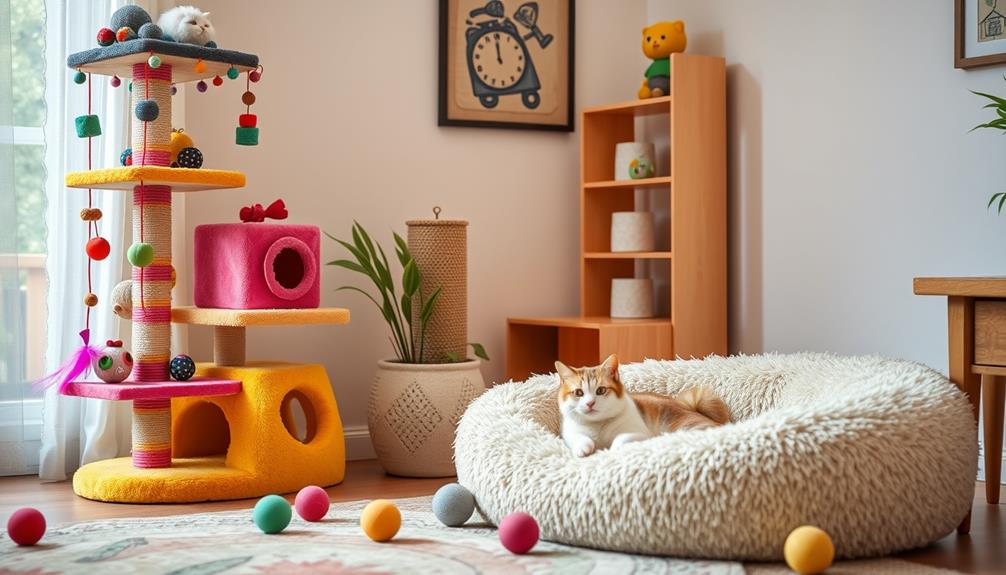
Finding engaging alternatives for your feline friend can greatly reduce their desire to jump on furniture. Start by providing a variety of toys, such as feather wands and interactive puzzles, to keep your cat mentally stimulated.
Catnip-infused toys can also attract them to designated areas, redirecting their attention away from furniture and encouraging playtime in more appropriate spots.
Don't forget about scratching posts! Offering posts made from different materials satisfies your cat's natural scratching instincts, making them less likely to seek out your furniture for this behavior.
Additionally, engaging in daily playtime activities, like laser pointer games or fetch with soft toys, provides essential physical exercise and helps curb their urge to lounge on your couch.
Lastly, create cozy hideaways or play structures using boxes and tubes. These alternative spaces give your cat places to explore and relax, diverting their interest away from your furnishings.
Environmental Enrichment
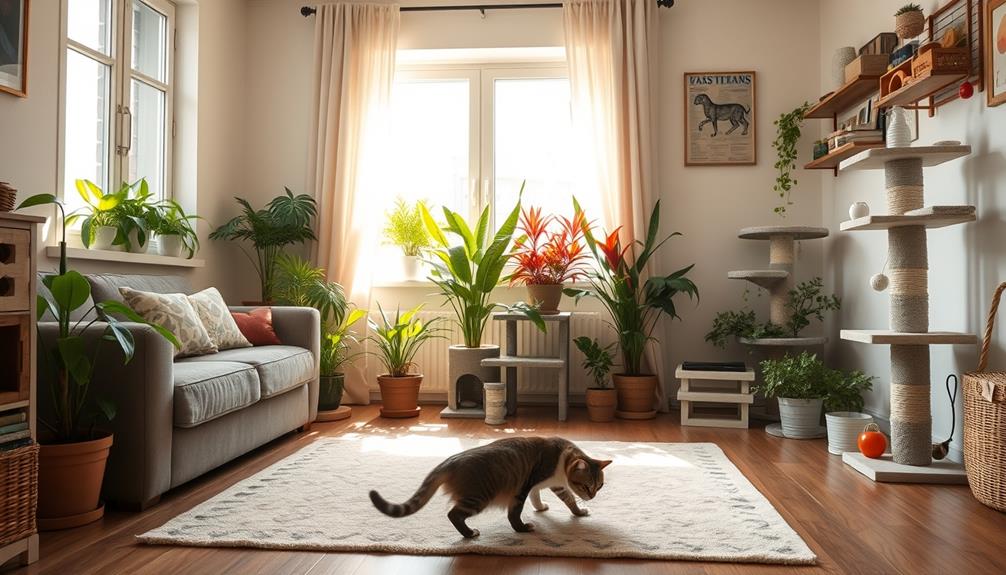
Environmental enrichment plays an essential role in keeping your cat happy and engaged while discouraging them from jumping on furniture.
By providing stimulating alternatives, you can redirect their instincts and keep them off your upholstery. Here are three effective strategies:
- Create High Places: Installing cat trees or shelves allows your cat to climb and explore. This satisfies their natural desire for height without resorting to your furniture.
- Provide Scratching Posts: Place scratching posts near your furniture to redirect your cat's scratching behavior. This not only protects your upholstery but also fulfills their need to scratch.
- Incorporate Interactive Toys: Using puzzle feeders and interactive toys keeps your cat mentally and physically active.
Regularly rotating toys introduces new challenges and maintains their interest, reducing the temptation to lounge on your furniture.
Consistency and Reinforcement
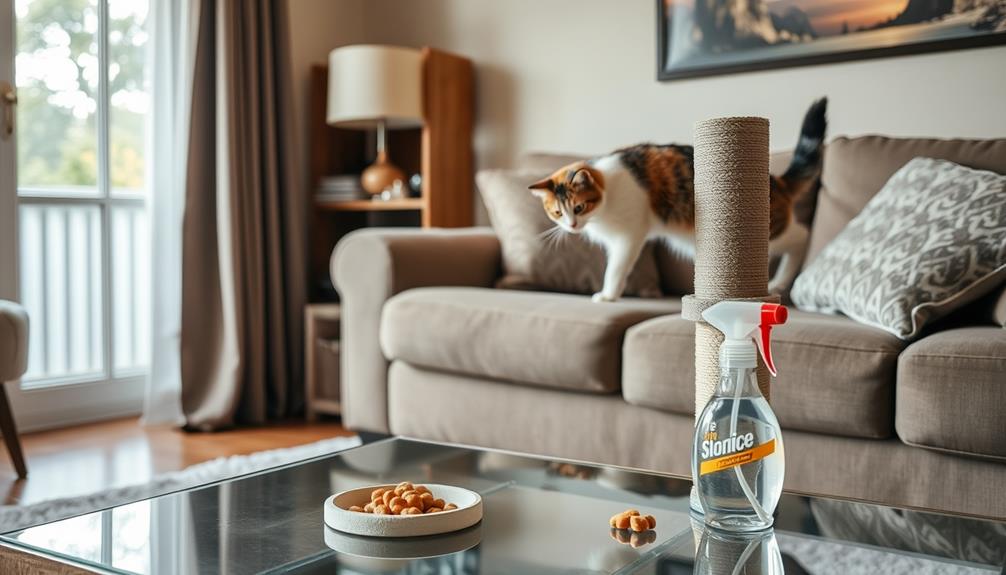
Establishing consistency in your training approach is crucial for keeping your cat off the furniture. Use firm vocal commands to create clear boundaries. When your cat jumps on the furniture, redirect them immediately to a designated area, like a scratching post. This action reinforces their understanding of what's acceptable.
Incorporate positive reinforcement by offering treats or praise when they choose appropriate surfaces. This encourages your cat to associate good behavior with rewards, leading to long-term behavior change.
Remember, consistency is key; repeat the same commands and rewards to solidify their learning.
You can also complement your training with deterrents like double-sided tape or cat repellant sprays. Applying these regularly alongside your training techniques enhances the effectiveness of your strategies.
Observing your cat's responses and adjusting your approach guarantees that your reinforcement remains effective.
Unique Solutions for Each Cat
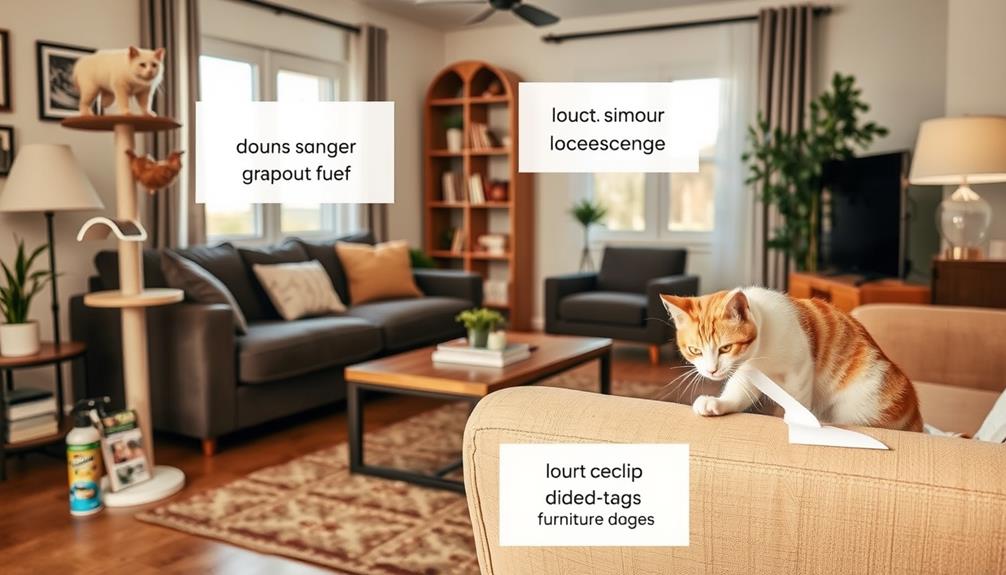
Every cat is unique, and understanding their individual preferences can greatly improve your efforts to keep them off furniture. To find unique solutions for each cat, you'll need to observe their behavior closely.
Here are three effective strategies:
1. Trial and Error: Experiment with different textures and scents. Some cats may dislike sticky tape or citrus scents, while others might find them unbothering.
Finding what deters your cat can take some time, but it's worth it.
2. Positive Reinforcement: Use treats or praise when your cat chooses the right surfaces. If they jump on their designated scratching post instead of the couch, reward them!
This approach may work well for some cats, while others might need firmer deterrents.
3. Environmental Enrichment: Create a stimulating environment by adding cat trees or climbing shelves.
This caters to your cat's natural instincts and provides alternative spaces to explore, steering them away from your furniture.
Frequently Asked Questions
What Repels Cats From Furniture?
To repel cats from furniture, use strong scents like vinegar or citrus sprays, apply double-sided tape for a sticky sensation, or place aluminum foil on surfaces. Commercial deterrents and textured mats also work effectively.
How to Get Cats to Stay off Furniture?
To get cats to stay off furniture, use firm commands and remove them when they jump on. Apply double-sided tape or repellents, and offer engaging alternatives like scratching posts to redirect their attention. If a cat continues to scratch furniture, consider trimming their nails or using nail caps to prevent damage. Additionally, providing plenty of mental and physical stimulation can help redirect their energy away from destructive behavior. Overall, consistency and patience are key in preventing cat furniture scratching.
How Do I Make My Furniture Cat Proof?
To make your furniture cat-proof, you'll want to apply deterrents, use unpleasant textures, and create appealing alternatives. By doing so, you'll protect your furniture while satisfying your cat's natural instincts in a healthier way.
What Is the Most Effective Cat Deterrent?
To deter cats effectively, try double-sided tape for its sticky sensation, vinegar spray for its strong odor, or citrus scents that cats dislike. Providing alternatives like cat trees can also redirect their attention.
Conclusion
By implementing these strategies, you'll transform your home into a cat-free furniture zone faster than a cheetah on the hunt! Remember, consistency is key—stick to your game plan, and soon enough, your cats will prefer a cozy bed over your prized sofa. With engaging alternatives and clever deterrents, you'll reclaim your space like a superhero reclaiming their fortress. Embrace these tactics, and watch your furniture stay pristine, while your cats happily engage in their own adventures!









